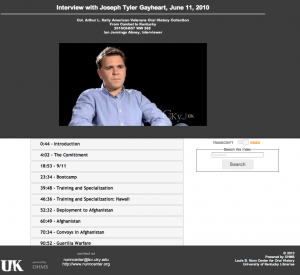 Oral History can be a difficult archival resource in an online environment. An Oral History interviewcan be hours long, containing limited metadata about the interview, is not searchable without a transcript and, even when there is a transcript, the textual representation often does not correlate to the recorded interview. As a result, the experience working with oral history online can be a challenge for both the archive and the user. The primary purpose for OHMS is to empower users to more effectively and efficiently discover information in an oral history interview online by connecting the user from a search result to the corresponding moment in an interview. OHMS is an open source, web-based application designed to improve the user experience you provide for oral history, no matter what CMS or repository you use. There are 2 main components of the OHMS system
Oral History can be a difficult archival resource in an online environment. An Oral History interviewcan be hours long, containing limited metadata about the interview, is not searchable without a transcript and, even when there is a transcript, the textual representation often does not correlate to the recorded interview. As a result, the experience working with oral history online can be a challenge for both the archive and the user. The primary purpose for OHMS is to empower users to more effectively and efficiently discover information in an oral history interview online by connecting the user from a search result to the corresponding moment in an interview. OHMS is an open source, web-based application designed to improve the user experience you provide for oral history, no matter what CMS or repository you use. There are 2 main components of the OHMS system
- OHMS Application: The OHMS application is where the work is done. This is the back-end, web-based application where interviews are imported, and metadata is created. In the OHMS application transcripts are time-coded and/or interviews are indexed. Upon completion, the interview record (including the synchronized transcript and/or time-coded index) are exported as an XML file. When located on a web server, the OHMS XML file is what interfaces with your content management system through the OHMS Viewer.
- OHMS Viewer: The OHMS viewer is the user interface of ohms. When an interview is called by the repository, the OHMS viewer loads, calling select interview level metadata and the intra interview level metadata created in the OHMS Application from the corresponding xml file.
View the following examples of the OHMS Viewer in action:
OHMS Viewer: synchronized transcript
OHMS Viewer: Synchronized Transcript + interview index
Sample OHMS XML File (Zipped for download)
To learn more about OHMS, read the article OHMS: Enhancing Access to Oral History For Free by Doug Boyd in issue 40, volume 1 of the Oral History Review.
